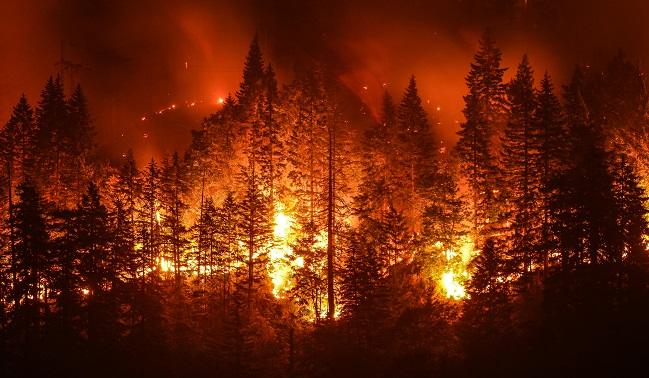Particulate Matter From California Wildfires Linked to Cardiovascular and Cerebrovascular Events
The researchers say measures are needed to increase awareness and help people decrease their exposure.

New data show a surprising pattern of increased emergency department (ED) visits for cardiovascular and cerebrovascular problems on days when wildfires are burning in California. Researchers say the fine particulate matter created by the fires poses significant risk beyond the state’s borders, and in particular to people over age 65, who appear to be most greatly affected.
The study adds to accumulating data on the association between air pollution and cardiovascular risk, and highlights the vulnerability of elderly patients with cardiac and vascular risk factors living in areas where the fires are common.
“It’s a local problem, but it’s also a national problem,” said the study’s senior author Ana G. Rappold, PhD (US Environmental Protection Agency, Durham, NC), in an interview with TCTMD. She noted that it is not uncommon for particulate matter from a wildfire in Alaska or the northwest territories to be detectable in the southern region of the United States, for example.
For the study, investigators led by Zachary S. Wettstein (University of California, San Francisco) looked at ED visits from May through September 2015, when intense wildfires were occurring in northern and central California. On days when smoke was most dense, visits for all-cause and individual cardiovascular diagnoses were highest across all age groups. For patients over age 65, this translated to a 42% increase in ED visits for MI, a 22% increase in visits for ischemic heart disease, and a 22% increased risk of heart failure. Visits for hypertension also were increased in elderly patients regardless of the density of the smoke, while increases in pulmonary embolism were greatest with medium and dense smoke.
It’s a local problem, but it’s also a national problem. Ana G. Rappold
Elevated risk of cerebrovascular disease was seen for all adults regardless of the condition of the smoke, while ischemic stroke diagnoses were increased only with lengthy exposure to smoky conditions in the age 65 and over group. Respiratory problems as a reason for the ED visit also were increased among all adults on the heavier smoke days, but again were most pronounced in the elderly.
The researchers also looked at two other medical conditions for comparison: appendicitis and long-bone fractures. Visit to the ED for these reasons were expected to be unaffected by the wildfires. However, while appendicitis was not increased, rates of long-bone fractures were unexpectedly higher than usual.
“It’s one of those interesting things that was observed and remains unexplained,” co-author Wayne E. Cascio, MD (US Environmental Protection Agency, Durham, NC), a cardiologist, told TCTMD. While the fractures could be coincidental, both Cascio and Rappold said it stands to reason that people experiencing cardiovascular or cerebrovascular events might fall due to lightheadedness or losing consciousness. Another possibility is being injured accidentally in dense smoke conditions, or being involved in car accidents, which Rappold noted occur more frequently during wildfires.
Individual Awareness and Protection Strategies Needed
Cascio said the study’s main value is that it confirms previous observations about the relationship between wildfire smoke and cardiovascular disease that had been inconsistent. Additionally, he said the study also sheds light on how the smoke interacts with the body since the outcomes observed are all related to blood clots.
“We do have to be mindful that smoke contains a lot of other chemicals and compounds apart from particulate matter, so we can’t say with absolute certainty that it’s the particulate matter. But, because we have such strong data for particulates in other situations, it’s very much likely that particulates are at the heart of much of this,” Cascio said.
The study relied on data from where people lived to determine their proximity and duration of exposure to the wildfires. Therefore, it is not known what level of physical activity they may have been doing, or if they took any measures on their own to decrease their exposure, such as using masks or ventilation devices in their homes. Rappold said this type of research is needed, and in fact, is ongoing as part of the EPA’s Smoke Sense Citizen Science Project. Anyone interested in participating in the study can download the Smoke Sense mobile app and use it to monitor air quality, see smoke forecasts and nearby smoke plumes as detected by satellites, and answer questions to improve their knowledge about the health effects of smoke exposure. The EPA also has a dedicated website called AirNow that shows current fire conditions and air quality in the United States and Canada.
To TCTMD, Cascio said he hopes the study helps raise awareness among clinicians that their patients with underlying cardiovascular risk factors and those who are elderly need education about how to decrease their chances of experiencing an event when air conditions are particularly bad.
L.A. McKeown is a Senior Medical Journalist for TCTMD, the Section Editor of CV Team Forum, and Senior Medical…
Read Full BioSources
Wettstein ZS, Hoshiko S, Fahimi J, et al. Cardiovascular and cerebrovascular emergency department visits associated with wildfire smoke exposure in California in 2015. J Am Heart Assoc. 2018;Epub ahead of print.
Disclosures
- The study authors report no relevant conflicts of interest.


Comments